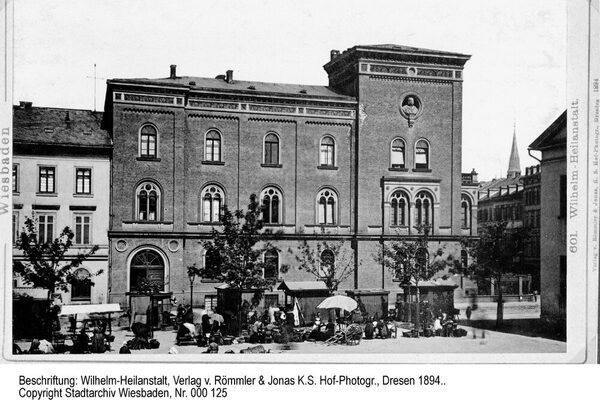Kaiser-Wilhelms-Heilanstalt
After the German War of 1866, the Prussian army administration decided to build a "Military Cure House for the Healing and Recovery" of Prussian military personnel in order to attract many sick and wounded members of the military to the spa town of Wiesbaden for their recuperation. The sanatorium, named after Kaiser Wilhelm I, was built between 1868 and 1871 under the direction of the Royal Chief Architect Philipp Hoffmann and in cooperation with the Berlin War Ministry.
In the style of historicism, a mighty castle-like building with a strict pilaster strip structure and round-arched friezes, round-arched gates and windows was built on Schlossplatz. The asymmetrically arranged risalit on the façade facing Schlossplatz rises above the roof cornice like a tower. The two massive towers on Mühlgasse create a successful corner solution and a conclusion on the side facing Schlossplatz. The sandstone bust of Emperor Wilhelm I by sculptor Carl Keil, which still exists today, was erected at mid-height of the dominant corner tower. Inside, living quarters were created for 88 men and eleven officers as well as bathing and spa facilities (16 bathing cells, a swimming pool), the design of which was entrusted to the architect Eduard Zais, son of the Kurhaus builder Christian Zais. The sanatorium, popularly known as the "bone mill", proved to be a "beneficial institute for the army and its members in the following decades and brought recovery and relief to many hundreds" (Rheinischer Kurier, 13.01.1902).
After 1945, the building served as a rheumatism clinic, but due to the low occupancy rate, it required such high subsidies that in April 1950, initial plans were made to close the sanatorium, which took place at the end of the year following a decision by the city council on December 7, 1950. The so-called Wilhelmsbau was subsequently converted into an office building for the city administration. No longer in use since the end of the 1970s, the Kaiser-Wilhelms-Heilanstalt was therefore incorporated into the Hessian State Parliament as an extension. The outer shell was retained, but the interior underwent extensive structural changes. The original three-storey building became a five-storey building to accommodate a large number of study rooms and meeting rooms.
Literature
Sigrid Russ, editor, Denkmaltopographie Bundesrepublik Deutschland. Cultural monuments in Hesse. Wiesbaden I.1 - Historical pentagon. Ed.: State Office for Monument Preservation Hesse, Stuttgart 2005 [p. 104].
Van den Bergh, Ulrike: The Hessian State Parliament. Ein Schloß als Parlamentssitz, Königstein/Taunus 1995 (Political and Parliamentary History of the State of Hesse 13) [pp. 155-157].
